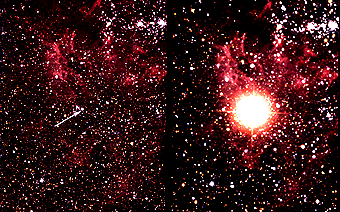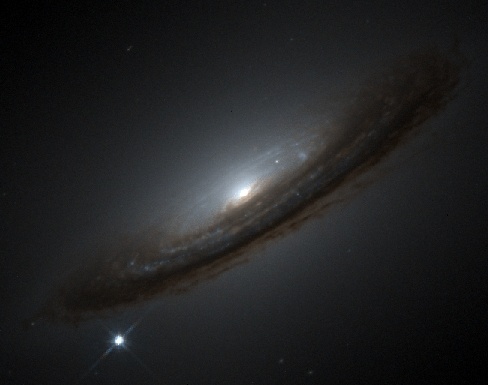Supernovae!
Iron won't undergo nuclear fusion. The center of that iron
core is squeezed down tightly and becomes degenerate, held
up by electron degeneracy pressure, rather than gas pressure.
But at the extremely high temperatures in the core, the
photons have enough energy to destroy nuclei:

This process is known as photodisintegration,
and it uses energy (endothermic), rather
than creating it (exothermic).
All of the sudden we have tons of protons and neutrons
running around in the core. In these extreme conditions (T ~ 8x109
K, rho ~ 1010 gm/cm3), free
electrons are captured by protons:
 So we get a burst of neutrinos, and the electrons are gone.
But
the electrons were holding up the star!
So we get a burst of neutrinos, and the electrons are gone.
But
the electrons were holding up the star!
Uh oh....
Core collapse
-
Because free-fall time depends on density, and the density
increases as you go deeper in the star, the inner
portions react first. At collapse speeds of 70,000 km/s, the inner
core collapses from 1 Earth radius to 50 km in one second.
-
This essentially pulls the rug out from under the upper layers.
They begin to collapse, too.
-
Once the density of the inner core reaches 1015
gm/cm3, the collapse stops. This is about the density of an
atomic nucleus, and occurs because of neutron
degeneracy. The core rebounds a bit, sending a blast wave outwards,
where it meets....
-
....the infalling outer layers.
-
BOOM!
A supernova is formed.
The outer layers are blasted off in a violent explosion. When they become
optically thin, so the energy can escape, we see the energy flooding out.
How much? The peak optical luminosity is around 109
Lsun, while 100 times more energy comes out in neutrinos (which
we don't see). This luminosity rivals that of an entire galaxy.
Here is a before and after picture of Supernova
1987A, the closest (d=50 kpc) supernova to us in modern times:

Here's a supernova (1994D) in a much more distant galaxy:

(Note to the purists: It's a Type Ia, not a Type
II...)
Note also that the plural of "supernova" is "supernovae",
not "supernovas"...




